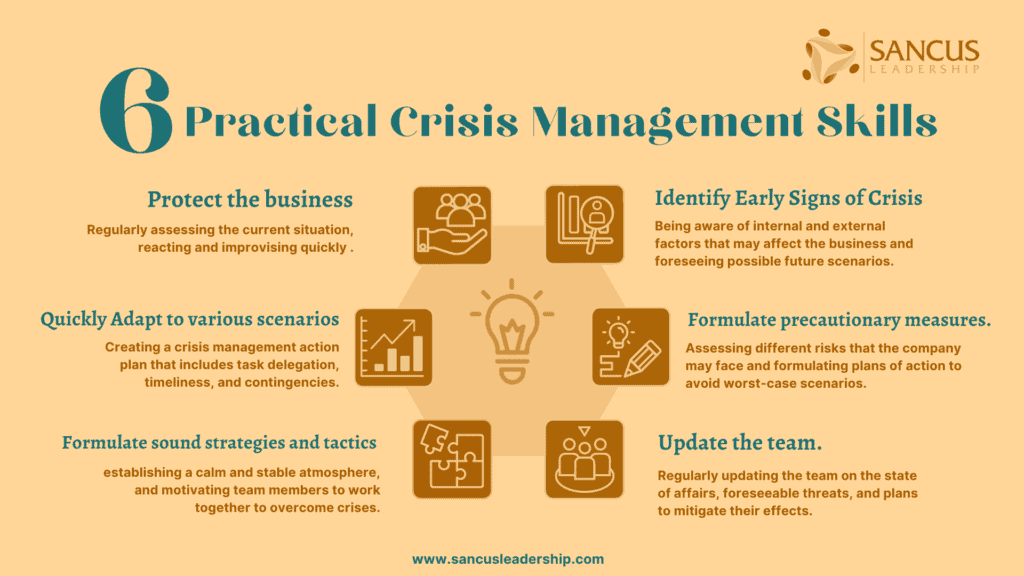Your cart is currently empty!

Will Crisis Management Skills Actually Save Your Business?
The difference between a crisis and routine change is primarily by the speed at which the situation changes. Medium-paced and incremental, and that’s everyday life for a business. Unexpected, violent, and immense, and now we have an emergency on our hands. If you want to succeed as a team leader or business owner in the long run, then crisis management will be a necessary skill to develop.
A leader with excellent crisis management skills can limit damage to a business by; Preparing contingency plans, training for crisis scenarios, and learning how to identify an upcoming emergency.
In this article, we’ll discuss the importance of crisis management skills and their impact on a business’s ability to survive crises. We’ll also discuss various types of crises and some tips on how they may be addressed. Let’s start!
Why Should a Leader Have Crisis Management Skills?

According to WEF, 69% of leaders will experience at least one crisis per five years; during the pandemic, hotels lost 90% of sales, but online sales grew by 180%. Companies with a contingency plan to “go online” significantly reduced the financial damage; this is why crisis management skills are essential!
All leaders should practice crisis management skills at all levels of a company. But what exactly is it that makes a leader handle a crisis well?
Practical crisis management skills include:
- Identify early signs of crisis.
- Formulate precautionary measures.
- Update the team.
- Formulate sound strategies and tactics.
- Quickly adapt to various scenarios – assess, improvise.
- Protect the business.

Let’s discuss these qualities and skills in detail:
Identify Early Signs of Crisis
A good leader should possess situational awareness wherein they are conscious of what’s going on internally (within the business) and externally (the broader environment to which the company belongs).
The leader must understand how these internal and external factors may affect the business so that they can anticipate possible future scenarios.
It’s also crucial for an effective leader to quickly identify relevant information and foresee their possible ramifications. In combination with filtering out the “irrelevant noise,” this is one of the best ways that any potential crises may be averted (or exploited).
Most importantly, a competent leader should be transformational. Old school, transactional leaders play it by the book. They lead and manage their team based on set rules and guidelines, and chances are that those are the same rules that got you into the crisis in the first place.
On the other hand, a transformational leader is able to:
- Step back and see the bigger picture. This allows them to see the scope of any potential crisis so they can formulate unique and appropriate strategies based on the scenario.
- Seek counsel from others. Competent leaders do not base all decisions solely on their own opinions and perspectives. They should consider others’ points of view and recommendations, especially those who are more knowledgeable and experienced on the issues at hand.
- Adapt to various situations. Good leaders are quick-moving and sharp in recognizing the need to better shift strategies and tactics to address specific issues. They acknowledge that structured regulations
- Work as a member of the team. A transformational leader must acknowledge that being the head of the team does not mean they are merely tasked to lead and manage subordinates. Instead, they recognize that they, too, must do their share in working with the team toward attaining the same goals.
Formulate Precautionary Measures
Situational awareness is only sufficient if it is supported by the ability to design protective measures to help avoid crises or minimize their impact on the business.
A good leader should be able to assess the different risks that the company may face, given various scenarios. From analyzing these risks, sound plans of action must be formulated to help avoid worst-case scenarios.
Identifying risks and planning for contingency is the most critical part of reducing the damages done by a crisis. That's why we at Sancus Leadership focus on risk assessment training with our clients. When you are ready to improve the defense of your business, you are welcome to contact us here.
Update the Team
The saying “no man is an island” is highly relevant, especially in business. A good leader must acknowledge that no matter how effective and skilled they are, the cooperation of everyone else in the team is crucial to the business’s survival and success.
A leader should regularly update the team on where the business is currently and where it is headed. The team should also be brought up to speed on any foreseeable threats, how these can adversely affect the business, and what the plans are to help mitigate their effects. This way, everyone can collectively work towards attaining the same goals.
Establish a “Crisis Anticipating” Atmosphere
All team members should feel that the business’ state of affairs is under control. A leader should be able to manage the team in a way that carries the message that they’re always in charge and on top of the situation.
Ensure that fear and doubt are not instilled in the team members’ minds. Aim to imprint the perspective that crises are obstacles the team can overcome together. A skilled leader should inspire the team members to act together so the business will survive despite tough times.
A good leader must motivate team members to work together for the betterment of the company. Ensuring the team that crises are merely phases in a business’ lifespan is vital. These are mere obstacles that, once conquered, will serve to strengthen the business further.
One way to establish a calm and stable atmosphere within the team and to motivate each member is by fostering trust and a sense of security.
One way to establish a calm and stable atmosphere within the team and to motivate each member is by fostering trust and a sense of security.
Conducting regular brainstorming sessions provides an excellent opportunity for this since each team member will feel important and that their opinions or suggestions are valid. Transparency is vital to promoting a healthy working environment.
Formulate Sound Strategies and Tactics
The whole team counts on a leader who can swiftly address various issues through sound strategies and tactics and can lead the team through their implementation.
A solid crisis management action plan spearheaded by a competent leader should, at a minimum, include the following:
- Task delegation. Team members must be given unique roles and responsibilities so that strategies and tactics may be swiftly implemented.
- Timeliness. Implementation should be well-timed to address various situations and dilemmas appropriately.
- Contingencies. The best, the worst, and the most likely scenario should be assessed and planned. Mitigate the worst and work toward making the best more likely to occur.
The best, the worst, and the most likely scenario should be assessed and planned. Mitigate the worst and work toward making the best more likely to occur.
Quickly Adapt to Various Scenarios
A good leader must regularly assess the current situation so that any hiccups and gains will be swiftly recognized. They should be quick on their feet to react and improvise, depending on what the situation calls for.
Effectively managing and leading a team also calls for someone willing to take calculated risks on time. A leader should be able to discern which issues need to be addressed straightaway and which ones are better off shelved for the time being, either due to the lack of urgency or the likelihood that developments are yet to unfold.
Protect the Business
In business, a crisis is an unforeseen matter that can have lasting adverse effects. Depending on the type of business you are engaged in, you may encounter multiple types of crises, and they can come from different directions.
Here are some of the most common crisis situations and some ways how they can be adequately addressed to protect the business:
Environmental
Natural disasters are almost entirely inescapable. They are the most common cause of crises in the US and frequently render the most destruction to any business. Properties may be damaged, and facilities may be completely destroyed. Employees may get hurt or even die. A company may also face shortages in resources and manpower.
The key to equipping your business with the right tools to face various environmental factors is preparation. For instance, invest in earthquake-resistant materials when constructing or renovating your workplace. This will help lessen the impact of natural disasters on your business, such as storms, tornadoes, or earthquakes.
Financial
A financial crisis is usually the result of a considerable loss or unexpected expense due to local or global events. It can be brought about by damages incurred during a natural disaster, a product recall, or structural renovations. Both of which can create a massive dent in the business’ wallet.
But according to Oracle, the most common reason for a financial crisis is something way less remarkable, managing cash flow. Many businesses need to bring in more money to sustain themselves.
Not all crises are extraordinary or worthy of a page in the new york times, but they must be dealt with when they arise.
A Manager with good crisis management skills will identify a situation like this early on and initiate contingency plans. Still, an excellent leader will have set up an early warning system to monitor and altogether avoid the problem.
Customer-Related
“The customer is always right.” This is not correct at all; we, as team leaders and business owners, must be able to operate ethically and in support of our people. That sometimes means telling people their behaviors are unacceptable and their money is unwanted.
But this must be balanced with the knowledge that an unhappy customer can wreak havoc on your business, so overall customer rights and satisfaction must be appropriately managed.
Customer injuries and lawsuits are other matters that can profoundly impact your business’ reputation.
Workforce-Related
Even more important is the happiness and satisfaction of your business’ workforce. Your team members are the driving forces essential to the survival and success of the company; with great teams, you can always find more opportunities to make money.
If not swiftly addressed, a workforce-related crisis can quickly bring the entire business down. The telltale signs are reduced productivity, recurring absentees, and frequent disputes among team members and leaders.
The best way to ensure your people are engaged and committed long term is to forge unbreakable trust; we use real-life adversity instead of made-up team-building exercises to create genuine relationships between people in a company.
The best way to ensure your people are engaged and committed long term is to forge unbreakable trust.
When you are ready to stop hiring new people every single year, and want to focus on revenue generating activities, then I invite you to book a free call here and see if we should work together!
It is essential to establish a positive environment within the team. Morale should be kept high, and teamwork should always be encouraged. Maintain open communication lines between team members and leaders so that any grievances and feedback will be swiftly addressed.
Reputational Damage
A business’s reputation is vital, especially when technology and social media make information accessible with just the tap of a finger. The survival of your business in such a competitive and unforgiving world relies a lot on how it is perceived by others, especially by its target market.
Even the most conservative of businesses have already jumped on the social media bandwagon. It is easy to air out complaints, opinions, and reviews, especially since people can be anonymous. It is a double-edged sword — an effective marketing tool that helps grow a business much more straightforward but can also utterly ruin a business in a heartbeat.
Ensure that your social media presence is constant yet reserved. Make it a point to make your company highly visible because this can significantly drive up business for the team. Maintain an aura of professionalism, reliability, and excellence and swiftly address any complaints and grievances.
In the short video below, Leadership Expert Amy C. Edmondson provides clear advice and examples to help any leader rise to the occasion. She offers practical wisdom and insight into how we can adapt and thrive amid changing workplace conventions.
| Qualities/Skills | Description |
| Identify Early Signs of Crisis/ Situational Awareness | Being conscious of what’s going on internally and externally and how it may affect the business |
| Formulate Precautionary Measures / Risk Management | Assessing the different risks that the company may face, given various scenarios, and formulating sound plans of action to avoid worst-case scenarios |
| Update the Team / Team communication | Regularly updating the team on the current state and foreseeable threats and establishing a calm and stable atmosphere |
| Establish a “Crisis Anticipating” Atmosphere | Delegating tasks, timely implementation, assessing and planning contingencies, and adapting to various scenarios |
| Quickly Adapt to Various Scenarios / Quick decision-making | Regularly assessing the current situation, quickly recognizing hiccups and gains, and taking calculated risks on time |
| Protection of business | Adequately addressing various crisis situations, such as environmental crises, legal issues, and cyber threats |
Final Thoughts
Crisis management starts with a team leader who can effectively manage and lead the team. A good leader in crisis should anticipate and plan for threats and can make decisions in a fast-paced environment.
A good crisis management action plan can be broken down into these steps:
- Identification of threats and risks
- Formulating sound strategies and tactics
- Well-timed implementation
- Reviewing results
- Protecting the business
Through all these, communication and trust are among the key factors ensuring success. Open lines of communication coupled with confidence in how competent the business leaders are will assure the team that they are in good hands.
